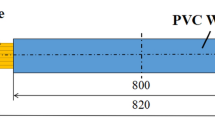Conclusions
-
1.
A change in the structure over the length of the wire, beginning at the terminal, is a basic structural indication of current overload; there is no coarse-grain segment in the vicinity of the burn zone.
-
2.
The magnitude of the overload can be estimated by comparing the distances from the terminal to the segments with the recrystallized structure and (or) burn; the higher the overload, the smaller these distances.
-
3.
A coarse recrystallized grain near the burn zone and an extended region with a partially recrystallized structure are indications of local external heating.
-
4.
A finer grain in the burn zone as compared with the coarse-grain structure of the recrystallization zone is an indication of an overload that precedes heating to 600°C.
Similar content being viewed by others
Additional information
VNKTs MVD SSSR. Scientific Production Union, All-Union Scientific-Research Institute of Aviation Materials. Translated from Metallovedenie i Termicheskaya Obrabotka Metallov, No. 8, pp. 61–63, August, 1990.
Rights and permissions
About this article
Cite this article
Rossinskaya, E.R., Stepanov, B.V., Sandler, V.S. et al. Effect of heating by electric current and external heating on the structure of aluminum wire. Met Sci Heat Treat 32, 631–634 (1990). https://doi.org/10.1007/BF00700721
Issue Date:
DOI: https://doi.org/10.1007/BF00700721




